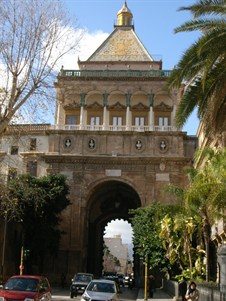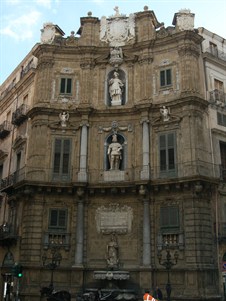Porta Nuova, the Palace of the Normans and the Quattro Canti
 After this silent reminder, the viceroy can see the Porta Nuova, another testimony of the Baroque apparatuses (Figure 1). Then, he finally arrives at his palace, which is also decorated for the occasion. Even in this case we are faced with a building that dates back to the Middle Ages, as indeed its very name states and by which it is known today: the Palace of the Normans. The building, however, underwent substantial changes between the sixteenth and seventeenth centuries, in accordance with the function of the center of the government of the Kingdom. The Viceroy Duke of Maqueda, recounts that, he «levò all’edificio la forma di castello e ve ne diede un’altra di palagio». Around the courtyard that still bears his name, there are open spaces for the magistracy of the Kingdom and for the parliament.
After this silent reminder, the viceroy can see the Porta Nuova, another testimony of the Baroque apparatuses (Figure 1). Then, he finally arrives at his palace, which is also decorated for the occasion. Even in this case we are faced with a building that dates back to the Middle Ages, as indeed its very name states and by which it is known today: the Palace of the Normans. The building, however, underwent substantial changes between the sixteenth and seventeenth centuries, in accordance with the function of the center of the government of the Kingdom. The Viceroy Duke of Maqueda, recounts that, he «levò all’edificio la forma di castello e ve ne diede un’altra di palagio». Around the courtyard that still bears his name, there are open spaces for the magistracy of the Kingdom and for the parliament.
 Political action, as you know, is to be explained not only in decision but also with consensus-building; parades, festivals, processions offer the opportunity of power to increase consent. Sometimes, the scene of these events is the open space in front of the royal palace. More often, however, the theater of urban performances is the distant Piazza Marina. An integral part of the show is then the procession which leaves the rooms of the palace and follows the CassaroThe road is the result of decades of hard work. It began on the opposite side of the city, where there are the Royal Palace and the Cathedral, in 1567. The work continued in stages, with a certain slowness, because it was to demolish most of the buildings that are located on the street towards the port. All was concluded only in the early eighties of the sixteenth century. to reach the sea. Once again an opportunity is offered to ephemeral constructions which decorate the way, and once again, fortunately for us, some of these ephemeral creations remain, in stone, as a spectacular testimony: piazza Vigliena, named after the viceroy that inaugurated it, better known as the Quattro canti, Four corners in Palermo and in the world as l’Ottangolo, the Octagon, the Teatro del Sole (Figure 2, one of the facades), a superb setting for the town celebrations by Giulio LassoGiulio Lasso (1565-1617) was a Florentine architecht, best known for his works in Sicily. Piazza dei Quattro Canti in Palermo is his most famous work. and Mariano SmiriglioArchitecht, painter and decorator from Palermo, Mariano Smiriglio (1561-1636) was one of the main protagonists of Sicilian art during the first half of the XVII century.. It is the intersection between the Cassaro and Via Maqueda.
Political action, as you know, is to be explained not only in decision but also with consensus-building; parades, festivals, processions offer the opportunity of power to increase consent. Sometimes, the scene of these events is the open space in front of the royal palace. More often, however, the theater of urban performances is the distant Piazza Marina. An integral part of the show is then the procession which leaves the rooms of the palace and follows the CassaroThe road is the result of decades of hard work. It began on the opposite side of the city, where there are the Royal Palace and the Cathedral, in 1567. The work continued in stages, with a certain slowness, because it was to demolish most of the buildings that are located on the street towards the port. All was concluded only in the early eighties of the sixteenth century. to reach the sea. Once again an opportunity is offered to ephemeral constructions which decorate the way, and once again, fortunately for us, some of these ephemeral creations remain, in stone, as a spectacular testimony: piazza Vigliena, named after the viceroy that inaugurated it, better known as the Quattro canti, Four corners in Palermo and in the world as l’Ottangolo, the Octagon, the Teatro del Sole (Figure 2, one of the facades), a superb setting for the town celebrations by Giulio LassoGiulio Lasso (1565-1617) was a Florentine architecht, best known for his works in Sicily. Piazza dei Quattro Canti in Palermo is his most famous work. and Mariano SmiriglioArchitecht, painter and decorator from Palermo, Mariano Smiriglio (1561-1636) was one of the main protagonists of Sicilian art during the first half of the XVII century.. It is the intersection between the Cassaro and Via Maqueda.
